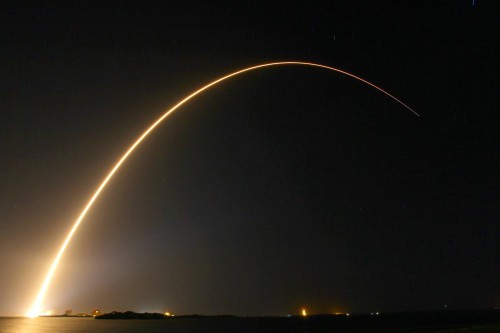
Fire and thunder were the name of the game today, as a United Launch Alliance (ULA) Atlas V booster roared away from Cape Canaveral Air Force Station, Fla., at 8:48 p.m. EST. The spectacular launch, which occurred right on the opening of a 40-minute “window,” took place from the Cape’s storied Space Launch Complex (SLC)-41. Within two hours, NASA’s eleventh Tracking and Data Relay Satellite (TDRS-K)—the first in a new “third generation” which will support many of the space agency’s communications and data-relay needs through the next decade—had begun the process of insertion into geosynchronous orbit, more than 20,000 miles above the Earth, and engineers are presently working through the deployment and testing of its solar arrays, antennas, and sophisticated communications payload.
In fact, TDRS-K is the most advanced satellite of its kind yet to enter space. It forms the first of three members of the new “third generation” of TDRS, the inaugural contracts for which were signed between NASA and Boeing in December 2007. Under the terms of that agreement, the aerospace giant would build the TDRS-K and L satellites, at a cost of $695 million, in order to “ensure vital operational continuity” of an on-orbit network which presently has the potential to support dozens of spacecraft, including the International Space Station and the Hubble Space Telescope.
“ULA and our mission partners are honored to work with the outstanding NASA team, and we are proud of the vitally important data relay capabilities that were safely delivered today,” said Jim Sponnick, ULA vice president, Mission Operations.
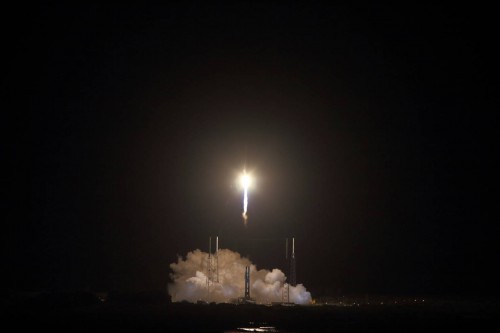
The NASA-Boeing deal is expandable to $1.2 billion, if all options are exercised, and this indeed seemed to be the case when the space agency ordered a third new satellite, TDRS-M, in November 2011. According to the Goddard Space Flight Center in Greenbelt, Md., which runs the network for NASA, TDRS-L is now well into the final months of systems testing and is expected to be declared “Launch Ready” in April. Current projections anticipate its launch—also aboard a ULA Atlas V—in January 2014, followed by TDRS-M in December 2015. All three satellites are designed for 15-year operational life spans, which allows for continuity until the middle or even the end of the next decade.
“TDRS-K bolsters our network of satellites that provides essential communications to support space exploration,” said Badri Younes, deputy associate administrator for Space Communications and Navigation at NASA Headquarters in Washington. “It will improve the overall health and longevity of our system.”
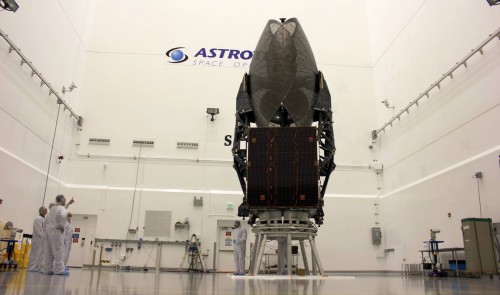
Emplacement of these next-generation TDRSes will coincide broadly with the retirement of the first generation of satellites, all launched by the shuttle in the 1980s and 1990s. Of this first generation, one (TDRS-B) was lost in the Challenger tragedy, whilst two others (TDRS-A and D) have already been shut down. The others are expected to follow within the next year or two. A second generation of three satellites—TDRS-H, I, and J—were launched between June 2000 and December 2002 and remain fully functional, despite having experienced a handful of technical difficulties of their own.
With the arrival of TDRS-K in orbit, a hiatus of more than a decade since the last launch has now closed. The new satellite is visually quite distinct from its cousins of the first generation. It is based upon Boeing’s “601” spacecraft bus—first introduced more than two decades ago, but extensively upgraded over the years—which can support multiple payloads and purposes, including direct TV broadcasts and the needs of private businesses and mobile communications users. The size and output of its communications payload has also expanded and is capable of housing up to 60 transponders and providing 10,000 watts of power.
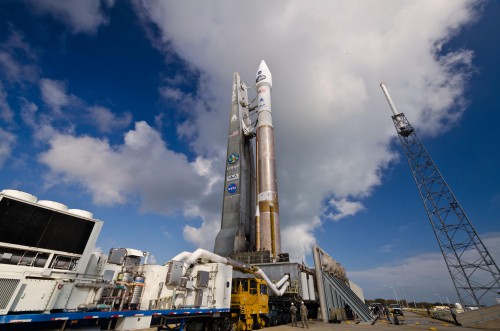
As well as enabling all navigation, power, propulsion, and command capabilities, the bus has twin solar arrays—each measuring 15 feet in diameter—for use whilst in direct sunlight and battery packs for use whilst in the Earth’s shadow. Its “spring-back” antennas are designed with flexible membrane reflectors, which fold up for launch and spring back into their original, “cupped” circular shape after insertion into orbit. The communications hardware consists of microwave equipment, a pair of gimballed antennas, and a phased-array antenna for forward, return, and tracking services. In addition to operating at S-band and Ku-band frequencies, the second- and third-generation TDRSes provide improved overall service and substantially higher bandwidth through the Ka-band.
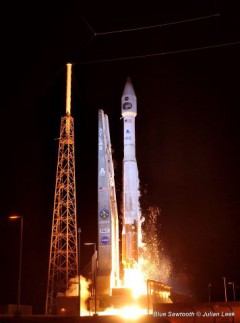
Today’s launch followed an exceptionally smooth processing flow, punctuated only by a 24-hour delay, caused by the need to remove, replace, and test an Ordnance Remote Control Assembly (ORCA), which had displayed “an anomalous signal indication before planned ordnance connections.” The ORCA work was completed by Thursday of last week, but pushed other pre-launch milestones slightly to the right.
In March 2009, Boeing selected the 19-story-tall Atlas V as its launch vehicle of choice for the third-generation satellites. To support TDRS-K mission requirements, the rocket flew in its pencil-like “401” configuration, equipped with a 4-meter (13-foot) payload fairing, no strap-on solid-fuelled boosters and a single-engine Centaur upper stage. The Atlas had been declared ready for flight at the start of December, and stacking of its components began earlier this month. The “core” segment was hoisted into position in the Vertical Integration Facility (VIF) at the Cape on 3 January, and the Centaur was attached over the weekend of 5/6 January. The ORCA replacement meant that the standard Launch Readiness Review took place a day later than planned, on Monday 28th, and the complete Atlas V/TDRS-K stack was transferred from the VIF to the SLC-41 pad surface early on Tuesday morning. Today’s launch progressed smoothly and the loading of propellants aboard the vehicle was conducted crisply, despite ominous forecasts of edge-of-the-envelope ground winds and thick cloud and a 40-percent chance of violating weather constraints. Two-and-a-half seconds before liftoff, the Atlas V’s Russian-built RD-180 engine roared to life, spooling up to its full 860,000 pounds of thrust by T-zero. Climb-out from SLC-41 commenced at T+1.1 seconds. The engine was fed by liquid oxygen and a rocket-grade form of kerosene, known as “RP-1,” and burned for a little over four minutes.
Shortly after clearing the tower, the Atlas executed a combined pitch, roll, and yaw program manoeuvre, which positioned it onto the proper 101.4-degree flight azimuth for the insertion of TDRS-K into orbit. A little over a minute into the flight, with the RD-180 still burning hot and hard, the vehicle burst through the sound barrier. At around this time, maximum aerodynamic stresses were felt through the Atlas’ airframe and the RD-180 was throttled back to 95 percent of its rated thrust. Slightly ahead of engine cut-off, at T+4 minutes and 22 seconds, the RD-180 throttled back to limit acceleration loads and, after separation, the turn came of the Centaur. The latter’s RL-10A engine, built by Pratt & Whitney Rocketdyne, was responsible for inserting TDRS-K into orbit.
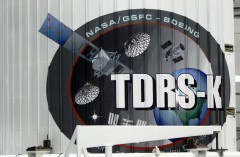
The RL-10A—which was at the center of a lengthy investigation last year, following an incident of abnormally low thrust during its otherwise successful effort to loft a Global Positioning System (GPS) satellite into orbit on 4 October—is capable of restarting in flight and supported two “burns” to inject TDRS-K. The first burn lasted for a little over 14 minutes and served to place the TDRS-K/Centaur into a “parking orbit,” after which the combo coasted for 82 minutes, ahead of a second burn, lasting just 59 seconds. Shortly after the completion of this second burn, the Centaur began a “Spacecraft Separation Attitude Alignment” and spun itself up to 5 revolutions per minute. Finally, 106 minutes after launch, TDRS-K was released into space to begin the complex process of deploying its solar arrays and communications payload. Several weeks of testing now lie ahead.
TDRS-K arrived at the Kennedy Space Center on 18 December, aboard an Air Force C-17 Globemaster III aircraft from the Boeing Space & Intelligence Systems assembly facility in El Segundo, Calif. Following its removal from the aircraft, the satellite was moved to Astrotech’s payload processing station, near the Kennedy Space Center. Over the Christmas period, it underwent electrical tests, and in early January its attitude-control system was fuelled, its batteries were charged, and on the 14th it was installed onto its Atlas V payload adapter. Two days later, TDRS-K was encapsulated within its two-piece protective shroud, and on the 20th the complete payload was mounted atop the Atlas V in the VIF.
Reflecting on the fact that more than a decade has elapsed since the last TDRS launch, Project Manager Jeffrey Gramling noted that the new satellite will “provide even greater capabilities to a network that has become key to enabling many of NASA’s scientific discoveries.”
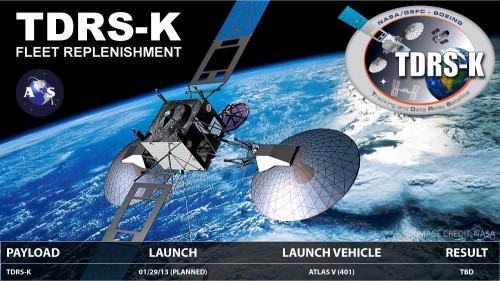




WOW!!! Cannot BELIEVE how FAST you got the story integrated & UP!!
GREAT INFORMATION, GREAT PIC and GREAT SPEED !!! Congratulations and THANK YOU for doing it SO WELL…..ALWAYS SOMETHING INTERESTING!!
I really enjoyed Mike Killian’s photo and thought it was the best one out there. Why wasn’t his used? I mean this one is good but but I know he worked hard one how he wanted it and had 99 shares last time I looked and thought he worked for you. Great Story!!! God Bless.
Julie,
Mike works for Zero G News. We’re fortunate enough to be able to use his work thanks to an agreement we have with Zero G News. Having said that, AmericaSpace has to balance gaining the best content for the best price.
Sincerely, Jason Rhian – Editor, AmericaSpace
—
jasonrhian@americaspace.com
813.235.3983